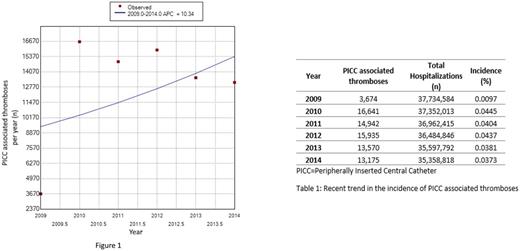Background
PICC can cause endothelial injury and inflammation leading to upper extremity DVT in up to 3% patients (Chest. 2010;138(4):803). PICC-associated upper extremity DVT can result in morbidity and financial loss. In recent years, professional societies have recommended avoiding inappropriate use of PICC whenever possible to reduce the incidence of complications such as DVT. In order to study the impact of these professional guidelines, we aimed to study the recent trends in incidence and financial implications of PICC-associated upper extremity DVT using National Inpatient Sample. This database is the largest publicly available all-payer inpatient database in the US.
Methods
We used the 2009-2014 National Inpatient Sample to identify adult patients (≥18 years) with primary or secondary diagnosis of PICC-associated upper extremity DVT. The diagnosis was established by combining International Classification of Diseases, 9th Revision, Clinical-Modification [ICD-9-CM] codes 453.82, 453.84, 453.85 and procedure code 38.93. Annual incidence of PICC-associated upper extremity DVT, length of stay (LOS) and cost of hospitalization were calculated for each year 2009-2014, fitted into a log-linear model and compared using Monte Carlo permutation test to study the changes over the years. Statistical analyses were done using STATA version 13.0 and Joinpoint Regression Program version 4.5.0.1. We used a 2-sided p- value of <0.05 to determine statistical significance.
Results
About 1.2% of patients receiving PICC developed upper extremity DVT. During the study period, no significant difference existed in the annual incidence of PICC-associated upper extremity DVT (95% CI: -18.0 to 48.4, p=0.4) (Figure 1). LOS was significantly higher in patients with versus without PICC-associated DVT (21 vs. 12 days, p<0.001). Cost of hospitalization was significantly higher in patients with versus without PICC-associated DVT ($243,346 vs. 127,933, p<0.001) (table 1). The study did not adjust for underlying diagnoses.
Conclusion
Although the annual incidence of PICC-associated upper extremity DVT remained unchanged in recent years, the overall risk of DVT was relatively small. Nonetheless, given the high utilization of PICC, even the small relative risk may result in a large absolute risk of morbidity and financial loss at the national level.
No relevant conflicts of interest to declare.
Author notes
Asterisk with author names denotes non-ASH members.


This feature is available to Subscribers Only
Sign In or Create an Account Close Modal